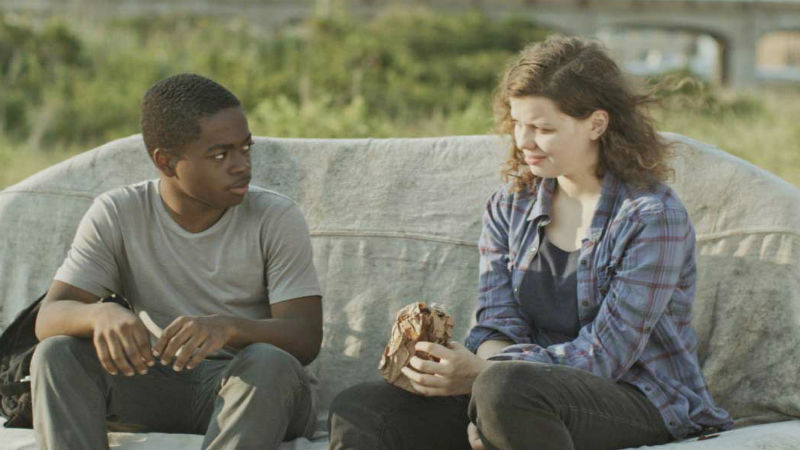
































Milo (Eric Ruffin) is a young teenager living at a bottom of the social ladder on a housing estate in New York. He’s obsessed with vampires. He kills people and drinks their blood. He’s also a loner taunted by a gang of bullies. Sizing up likely prey, he makes friends with potential victim Sophie (Chloe Levine) who lives on the ninth floor and as it turns out is being abused by her grandfather (who we never see). At home, Milo lives with his former soldier elder brother Lewis (Aaron Clifton Moten), their mother having committed suicide some time previously. Mother’s room and her suicide deathbed still haunt Milo, who periodically sneaks in there when he can get past his brother. When he’s not out stalking and hunting, he watches vampire movies, reads vampire novels and writes extensive observations on vampire lore in his notebook.
The film deals with race in the sense that many of the housing estate residents including Milo and his family are black, and white people visit thinking they can buy drugs off dealers on the estate. But equally, Sophie is white: perhaps this is a consideration when Milo first stalks her, but it quickly becomes apparent to both him and us that she’s just as much an unloved and struggling teenager as he is. Once this barrier has been broken, it’s clear that race isn’t an issue between them at all and a romantic entanglement ensues. But while Sophie is drawn to Milo, as she browses his vampire notebooks in his absence she starts to get cold feet.

There is an attempt to impose a plot – Milo has a run in with local gangs and playfully leads middle class white boy Mike (Danny Flaherty) trying to buy ‘C’ for himself and his girlfriend into a room where he meets the local gang who taunt him then (perhaps unintentionally) kill him. Milo is subsequently picked up by the cops which will have unforeseen consequences for him on the estate.
However the real interest here lies in the character of Milo himself, a conflicted, troubled soul trying impossibly to extract himself from harmful practices into which he has fallen. Ruffin gives an extraordinary performance as the boy, completely compelling and believable as well as beautifully understated. He’s matched by Levine as Sophie, even though she’s clearly the secondary character with less time on the screen.
Aside from the housing estate environment, the locations are school classrooms, underground carriage interiors, public lavatories and overgrown patches of waste land all of which add up to a bleak urban landscape matched by the barren interior terrain of the protagonist. Questions about God and money occasionally come up in conversation and an enthusiastic church congregation can be heard singing distantly in the background once or twice, but they barely impinge on Milo’s existence. Far from being a horror film per se, this is a powerful vision of a lost teenager’s desolate, internal world.
The Transfiguration is out in cinemas across the UK from Friday, April 21st. Meanwhile, you can still watch the film trailer below:
For an equally racially-charged if more mainstream horror movie, read our review of Jordan Peele’s Get Out, which is also out in cinemas right now.
















